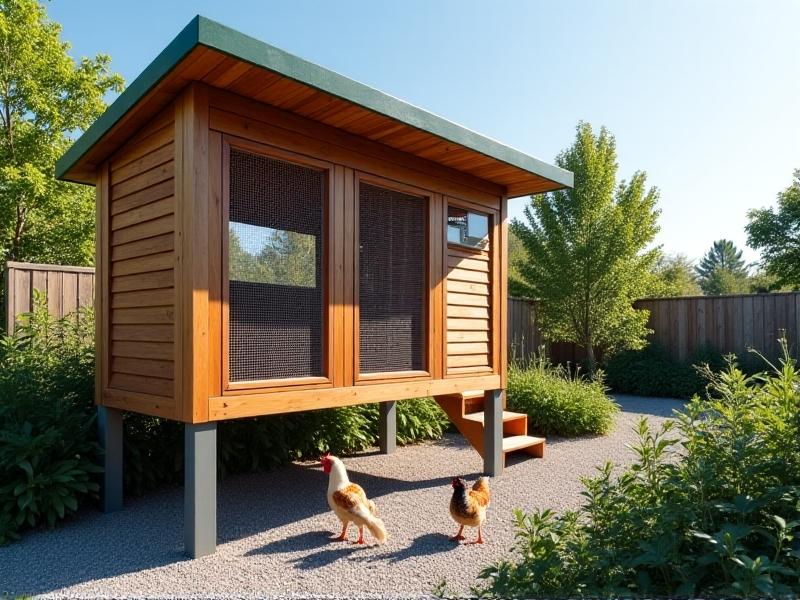Rat-Proofing Your Urban Chicken Setup: Critical Strategies
Understanding the Rat Problem in Urban Chicken Coops
Rats are drawn to chicken coops for three primary reasons: food, water, and shelter. Urban environments often provide ample opportunities for rodents to thrive, especially near livestock. Chickens’ feed, spilled grains, and even their droppings can attract rats. Once rodents establish a presence, they pose health risks to both chickens and humans, spreading diseases like salmonella and leptospirosis. Understanding their behavior—such as their ability to squeeze through tiny gaps and chew through weak materials—is the first step in designing a rat-proof system.

Building a Fortified Coop Structure
Rats excel at exploiting structural weaknesses. Start by elevating the coop at least 12 inches off the ground using sturdy materials like metal legs or concrete blocks. Ensure walls and floors are constructed with ½-inch hardware cloth instead of chicken wire, which rats can easily gnaw through. Seal all gaps around doors, vents, and nesting boxes with silicone caulk or steel wool. Install automatic coop doors that close at dusk to prevent nocturnal rodent intrusions. A well-built coop not only deters rats but also improves overall chicken safety.

Securing Food and Water Sources
Rats can survive on just 30 grams of food per day—making even minor spills a feast. Use treadle feeders that open only when chickens step on them, or store feed in galvanized metal bins with tight-fitting lids. Hang waterers above ground level and use nipple-style systems to minimize spillage. Clean feeding areas daily, and avoid scattering scratch grains. Consider feeding chickens during daylight hours only, removing leftovers before nightfall when rodents are most active.

Managing Waste and Compost Effectively
Chicken manure and soiled bedding are irresistible to rats. Store waste in lidded, rodent-proof compost bins placed away from the coop. Avoid adding meat or kitchen scraps to compost piles, as these attract pests. Turn compost regularly to accelerate decomposition and reduce odors. For bedding, use sand or hemp instead of straw, which retains moisture and provides nesting material. Deep litter methods should be avoided in rat-prone areas, as they create ideal hiding spots.

Landscaping to Discourage Rodent Activity
Overgrown vegetation and clutter offer rats cover and nesting sites. Maintain a 3-foot gravel or concrete barrier around the coop to eliminate hiding places. Trim shrubs and tree branches that overhang the coop, as rats use these as bridges. Install motion-activated lights to disrupt nocturnal activity. Avoid using dense ground covers like ivy near the coop—opt for short grass or bare soil instead. Strategic landscaping reduces habitat appeal while enhancing coop visibility.
Implementing Monitoring and Maintenance Routines
Regular inspections are critical. Check for new burrows near the coop, gnaw marks on wood, or droppings in corners. Set up wildlife cameras to monitor after-hours activity. Reapply sealants to expanding gaps seasonally, and replace worn hardware cloth promptly. Involve neighbors in rodent control efforts, as rats often travel between properties. Consistent maintenance ensures early detection and long-term prevention.
Natural Deterrents and Non-Toxic Solutions
Peppermint oil-soaked cotton balls repel rats due to their aversion to strong scents. Plant mint or lavender around coop borders as a natural barrier. Encourage predators like owls by installing nesting boxes nearby. Ultrasonic repellents may supplement other strategies but shouldn’t be relied upon alone. Avoid poisons, which can harm chickens and wildlife—opt for live traps if necessary, releasing captured rats far from residential areas.
Emergency Response: When Rats Breach Defenses
If rats infiltrate your coop, act immediately. Remove all food sources and set multiple snap traps baited with peanut butter. Temporarily relocate chickens to disrupt rodent routines. Conduct a full security audit—rats often return to previously accessed locations. Deep-clean the coop with vinegar solution to eliminate scent trails. After resolving the issue, reinforce weak points with additional hardware cloth or concrete barriers to prevent recurrence.








